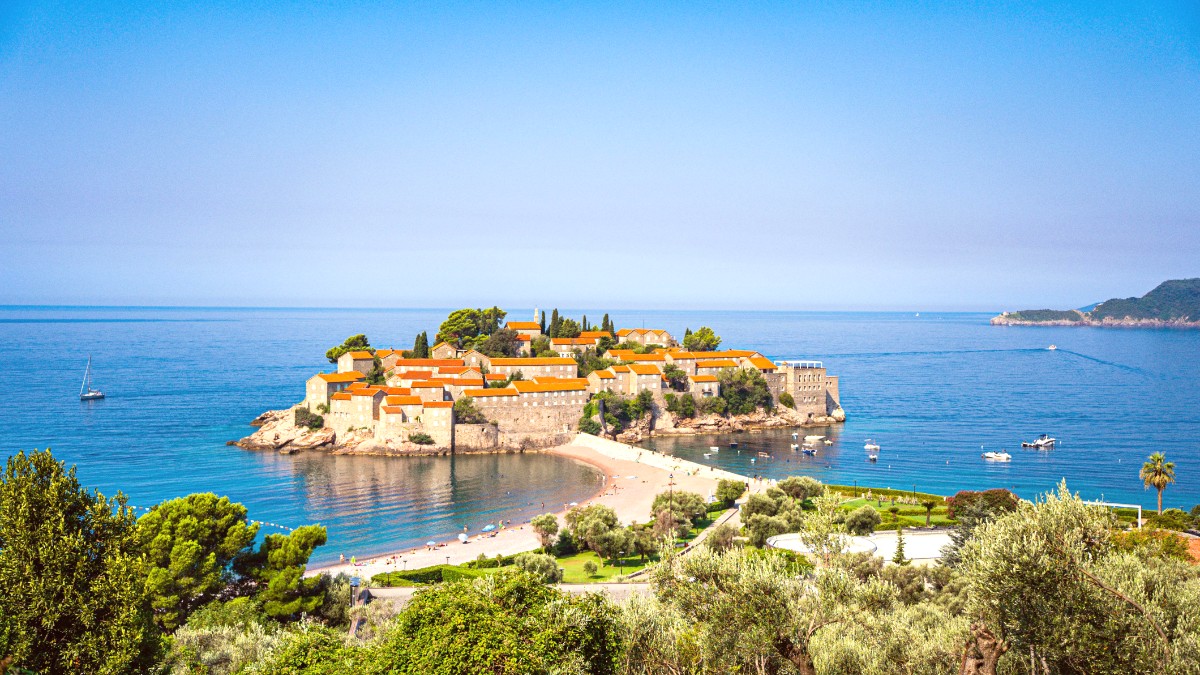
Montenegro
Montenegro's Adriatic coastline favors a Mediterranean diet, influenced by Italian and Venetian culinary traditions, with fresh seafood, olive oil, and herbs. Inland, cuisine leans towards Balkan and Ottoman influences, with heartier meat and dairy dishes. This blend yields a diverse gastronomic experience.
Coastal Cuisine: Abundant fresh fish, shellfish, olive oil, ripe tomatoes, bell peppers, zucchini, eggplant, leafy greens. Local cheeses, `pršut` (air-cured ham), and herbs like rosemary, oregano, thyme, and bay leaves are common.
Focuses on robust meat dishes (lamb, beef, pork), often slow-cooked or grilled. Potatoes, cabbage, and corn are main vegetables. `Kajmak`, a rich, creamy, fermented dairy product, is a popular accompaniment.
Sveti Stefan, on the Budva Riviera, mainly showcases Mediterranean-style Montenegrin cuisine with plenty of fresh seafood, grilled fish, risottos, and pasta dishes. Nearby Budva provides a broader range of dining experiences.
Garlic and onions are used in almost every savory dish. Paprika is a common spice, adding gentle warmth and color.
A rich and flavorful fish soup, often with various types of local fish and vegetables. A coastal staple found in traditional seafood restaurants (`konobas`) in Sveti Stefan, Pržno, or Budva.
A staple along the coast.
A distinctive dish colored and flavored with squid ink, typically with pieces of squid, octopus, or cuttlefish. It has a rich, earthy, and slightly briny taste. Available in most coastal seafood restaurants.
A must-try for seafood lovers.
Pljeskavica: A large, seasoned grilled meat patty. Ćevapi: Small, finger-shaped grilled sausages. Both are often served with `kajmak` and `lepinja`. Njegoški Pršut: Air-cured ham from Njeguši, with a distinct smoky flavor, often a cold starter.
Widely available at grill stands and casual eateries.
Flaky pastry filled with meat, cheese, spinach, or potatoes. An inexpensive option for breakfast or snack, found in any `pekara` (bakery).
Palačinke are thin crepes with sweet fillings. Baklava is a sweet pastry with layers of filo, nuts, and syrup, an Ottoman legacy.
Aman Sveti Stefan: The island resort hosts exclusive fine dining for guests (The Piazza, The Olive Restaurant). Exceptional cuisine, stunning views, impeccable service. Non-guests might secure reservations with advance notice. Epitome of luxury dining.
Sveti Stefan village, Pržno, and Bečići have many mid-range restaurants. Many `konobas` (traditional taverns) mix local and international cuisine, specializing in grilled meats and fresh seafood.
For budget-friendly options, explore bakeries (`Pekara`) for `burek` and other pastries. Grill stands (`Roštilj`) offer affordable `ćevapi` and `pljeskavica`, more common in Budva.
Vegetarian dishes are generally available, focusing on grilled vegetables, salads, cheese, and pasta. Vegan options can be more challenging. Dedicated vegan restaurants are rare outside larger cities.
Communicate clearly: `bez mesa` (without meat), `posno` (fasting food, often vegan), or `biljna hrana` (plant-based food).
Halal and kosher options are extremely limited. Awareness of gluten-free (`bez glutena`) or other specific allergens is not widespread in all restaurants.
Carry a translation card. Focus on naturally gluten-free foods (grilled meats/fish, salads, rice, potatoes). For severe allergies, self-catering or pre-arranged meals at larger hotels are safest.
Limited in Sveti Stefan; found more in Kotor or Budva, focusing on regional dishes.
Possible day trips to olive groves, wineries (Skadar Lake), or `pršut` producers.
Seasonal festivals may occur in nearby towns (Budva, Bar) for local products.
Most unique dining experience on the island, offering luxury and a historic setting.
Use translation apps (Google Translate offline Montenegrin/Serbian) or a physical phrasebook for clear communication of dietary needs.
Consider a Translation card for specific allergies.
Consult hotel staff or guesthouse hosts for restaurant recommendations or to help explain dietary needs.
Larger supermarkets in Budva offer a wider range of packaged and specialty foods for specific dietary requirements.
Visiting the Budva Green Market is a cultural experience. Stock up on fresh produce, local cheeses, and `pršut` for picnics.
While Montenegrin and Mediterranean cuisine dominate, Budva offers a wider range of international options, including Italian, Turkish, and Chinese.
Exclusive fine dining at Aman Sveti Stefan's restaurants (The Piazza, The Olive Restaurant) for resort guests.
Many mid-range `konobas` (traditional taverns) in Sveti Stefan village and Pržno offer fresh seafood and local dishes.
Upscale dining at Kraljičina Stolica (Queen's Chair) Restaurant, near Sveti Stefan in Miločer Park, often with beautiful coastal views.
Carry a translation card in Montenegrin/Serbian for specific dietary requirements like gluten-free or vegan.
Specify `bez glutena` for gluten-free.
Hotel staff or guesthouse hosts can recommend suitable restaurants or help explain your needs to restaurant staff.
Larger supermarkets in Budva may have imported or specialty items.
Sveti Stefan’s culinary focus remains on fresh seafood and Mediterranean flavors, reflecting its coastal position. Enjoy local fish, risottos, and olive oil.
For a broader culinary journey, venture inland for heartier meat and dairy dishes influenced by Balkan and Ottoman traditions.
Optimize your food adventure by seeking out seasonal ingredients like fresh seafood in spring/autumn and figs in late summer.
Exploring Montenegro's food scene goes beyond just eating; it's a journey through its diverse cultural influences and local produce.